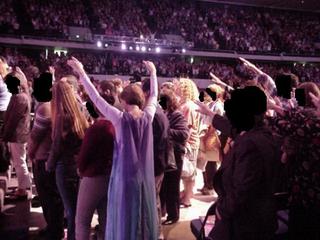Guilty Pleasures aka Liturgical Abuses
Have you ever been at Mass, possibly pondering some theological mystery—like the inner-relationship of the Trinity, the Hypostatic Union, or the eternal nature of God, and then you see your priest do something like this:
(Faces cencored out of respect. I have no intention of personally demeaning those depicted in these photos)

Well, if you haven’t then you can count yourself lucky. In the Church there are certain areas where the Sacred Liturgy is faithfully guarded buy the local Bishop. There are other areas where the Sacred Liturgy is frequently mixed with all kinds of “priestly improvisation." Let's evaluate some of the most frequent abuses I've seen/heard of.
1. The "We have Glass Vessels so you can 'see' the Consecration" abuse:

A.) Glass is not a sutable material for the Body and Blood of our Lord.
The 2002 GIRM gives the following guidance:
328. Sacred vessels are to be made from precious metal. If they are made from metal that rusts or from a metal less precious than gold, then ordinarily they should be gilded on the inside.
Redemptionis Sacramentum also states:
Reprobated, therefore, is any practice of using for the celebration of Mass common vessels, or others lacking in quality, or devoid of all artistic merit or which are mere containers, as also other vessels made from glass, earthenware, clay, or other materials that break easily.
B.) Precious blood must be distributed into the chalice before the Concecration
R.S. 106. However, the pouring of the Blood of Christ after the consecration from one vessel to another is completely to be avoided, lest anything should happen that would be to the detriment of so great a mystery. Never to be used for containing the Blood of the Lord are flagons, bowls, or other vessels that are not fully in accord with the established norms.
Same thing happens here:
2.) Then the "Sure, Dance isn't an integral part of worship in the Latin Rite, but so what?." abuse

In 1975, the Congregation for the Sacraments and Divine Worship wrote a document called "Religious Dance, An Expression of Spiritual Joy" (Quotations in this section taken from Catholic Answers: here). It stated:
Dance has never been made an integral part of the official worship of the Latin Church. If local churches have accepted the dance, sometimes even in the church building, that was on the occasion of feasts in order to manifest sentiments of joy and devotion. But that always took place outside of liturgical services. Conciliar decisions have often condemned the religious dance because it conduces little to worship and because it could degenerate into disorder.
And later:
Here dancing is tied with love, with diversion, with profaneness, with unbridling of the senses: such dancing, in general, is not pure."For that reason it cannot be introduced into liturgical celebrations of any kind whatever: that would be to inject into the liturgy one of the most desacralized and desacralizing elements; and so it would be equivalent to creating an atmosphere of profaneness which would easily recall to those present and to the participants in the celebration worldly places and situations.
Let's shy away from a legalistic argument against Liturgical Dance for a moment and just argue common sense Catholicism. How exactly does this:

Enhance this:

Then there is the scary part of it all...what exactly is this "dancer" going to do to the person infront of her? Looks kinda like she's going to eat her:

Catholics in California...You need to watch out because these "dancers":

...may be coming to "enhance your worship experience" at a parish near you ;)
3.) The "Say Hello to my Stole" Abuse

(By the way what liturgical color does that stole go with?)
The General Instruction of the Roman Missal States:
337. The vestment proper to the priest celebrant at Mass and other sacred actions directly connected with Mass is, unless otherwise indicated, the chasuble, worn over the alb and stole.
And Redemptionis Sacramentum adds:
123.“The vestment proper to the Priest celebrant at Mass, and in other sacred actions directly connected with Mass unless otherwise indicated, is the chasuble, worn over the alb and stole.”[213] Likewise the Priest, in putting on the chasuble according to the rubrics, is not to omit the stole. All Ordinaries should be vigilant in order that all usage to the contrary be eradicated.
and connected to that abuse...but with another couple thrown in is this:
Same issues here (found on L.A. Catholic) :
A.) The two priests on the sides have their stoles overlaid on their chasubles.
B.) What liturgical season is it? Look on the calander, it's Green or White--Not Both!
C.) I see only a chaliace--where is the Missal or the Ciboria with the hosts?
I'll make a series of these posts, not because I like to ding our priests (most of whom are absolutly wonderful), but because the average faithful Catholic should be familiar with the rubrics of the Mass and know what should and should not go on. The more everyone knows the more they can be proactive in fixing or preventing the liturgical abuses.

<< Home